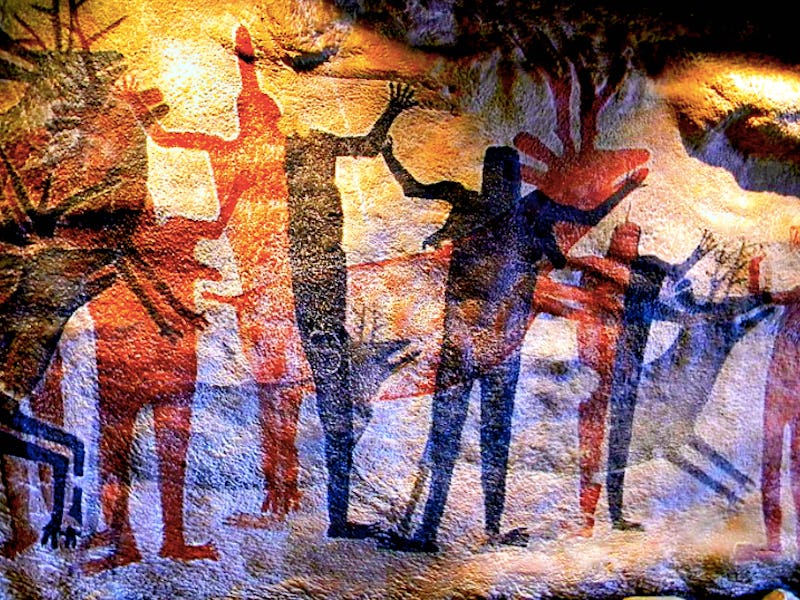Scientists Present New Theory Explaining Why We're the Only Humans on Earth
"So, we thought, why not turn to the most glaring fact of all?"

It’s easy to forget that we’re a single species within the genus Homo because everyone else is dead. Currently, it looks like Homo — a group of hominins that includes ancient beings like Homo erectus and Homo neanderthalensis — is a family of seven, though that number is debatable. Regardless, Homo sapiens are the only humans alive, and the reason why is still a mystery. In a paper released Monday, scientists float a new explanation: The reason our ancestors avoided extinction was because they could explore and adapt.
In Nature Human Behavior Patrick Roberts, Ph.D., and Brian Stewart, Ph.D., argue that humans have a “unique ecological plasticity” that put our ancestors at an advantage over other hominins. In other words, Homo sapiens are, and have been, very good at living in widely different parts of the world. According to Roberts and Stewart, the capacity to inhabit extremely different landscapes and the ability to learn the specialized skills necessary to thrive in those places means our species occupies a new ecological niche — that of the “generalist specialist.”
Some researchers have linked the survival of our species to our ability to create or communicate, but Roberts, a researcher at the Max Planck Institute for the Science of Human History, points out to Inverse that scientists are also increasingly aware that extinct hominins like Neanderthals were also capable of cultural expression and community caretaking. These are signs that those specialized capabilities weren’t ours alone, so they can’t be the only reason we survived.
“So, we thought, why not turn to the most glaring fact of all?” Roberts says. “That our species is the only one to have colonized the entire globe and all of its environments. This seemed to us to be the elephant in the room but somewhat neglected given the current focus on finding the latest fossil or flashy piece of jewelry or art.”
Ancient hominin migration routes
The team supports their argument with a review of previous archeological and paleoenvironmental research focused on ancient human dispersal between 300,000 to 12,000 years ago. Roberts and Stewart contend that the fossil record, as it stands now, demonstrates that anatomically modern humans had expanded to higher-elevation niches than their hominin predecessors and contemporaries by 80,000 to 50,000 years ago. At least 45,000 years ago, Homo sapiens were colonizing a range of intensely challenging settings, including deserts, tropical rainforests, and Palearctic regions.
That’s not to say that other members of the genus, like Homo erectus and Homo floresiensis, didn’t migrate far beyond Africa. But these ancient hominins stayed within an environmental comfort zone comprising a mixture of woodland and grassland. So far, says Roberts, we’ve only found fossil evidence of Homo sapiens in other settings, although “in some cases, like deserts, it remains debated how arid they were when humans got there.”
Map showing the minimum suggested dates of persistent occupation of different environmental extremes.
Still, there’s a lot of work to be done if this theory is to bring a close to the mystery of Homo sapiens’ survival. Shara Bailey, Ph.D., a paleoanthropology professor who was not a part of this research, says she would be cautious about saying where other hominins did or did not make their homes because the fossil record during the Middle Pleistocene is sparse in some parts of the world. Just because we don’t have evidence that non-sapiens weren’t specialists occupying extreme environments doesn’t mean they couldn’t have been.
Also, just because ancient humans were extraordinary migrators doesn’t mean their capacity for physical exploration alone was the only factor allowing them to travel. Melanie Chang, Ph.D., an anthropologist who was not a part of the study, reasons that “milestones” like early art indicate that ancient humans were culturally complex and behaviorally flexible, which likely helped them adapt to a wide range of environments. Furthermore, Bailey argues, demographic changes related to an increase in population size drove Homo sapiens’ innovations, which could have helped them occupy regions no one else wanted to go to.
Roberts and Stewart agree their theory is contingent on the fossil record as it stands, and for their part reason that Pleistocene Homo sapiens were able to adapt to extreme regions because of their ability to cooperate with people outside of their family.
Today, Roberts says, we can still see evidence of our ability to thrive in extreme environments — just look at the current space race or the fact that “we’re going deeper into the oceans and higher into the skies than ever before.” We’re still “generalist specialists,” but there’s no saying whether it will prevent us from eventually going extinct.
“Certainly it has allowed us to survive this far, though we should remember the sobering fact that we are still younger than Neanderthals and have only lived for 300,000 years [relatively limited in the context of human evolution],” Roberts explains. “So perhaps we don’t know if the ‘generalist specialist’ is a definitive success just yet!”